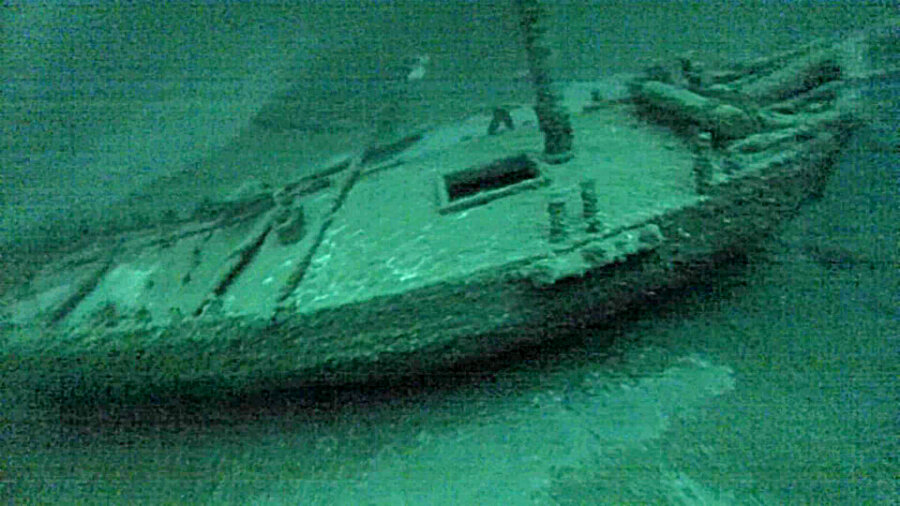Second-oldest Great Lakes shipwreck offers a rare window into the past
Loading...
The second-oldest confirmed shipwreck in the Great Lakes, an American-built, Canadian-owned sloop that sank in Lake Ontario more than 200 years ago, has been found, a team of underwater explorers said Wednesday.
The three-member western New York-based team said it discovered the shipwreck this summer in deep water off Oswego, in central New York. Images captured by a remotely operated vehicle confirmed it is the Washington, which sank during a storm in 1803, team member Jim Kennard said.
"This one is very special. We don't get too many like this," said Mr. Kennard, who along with Roger Pawlowski and Roland "Chip" Stevens has found numerous wrecks in Lake Ontario and other waterways.
The sloop Washington was built on Lake Erie in Pennsylvania in 1798 and was used to transport people and goods between western New York, Pennsylvania, and Ontario. It was placed on skids and hauled by oxen teams across the Niagara Isthmus to Lake Ontario in 1802 after being sold to Canadian merchants.
Since there are no known drawings of the Washington, the sloop's discovery will help maritime historians learn more about the design and construction of that type of sailing vessel used on the Great Lakes between the American Revolution and the War of 1812, according to Carrie Sowden, archaeological director at the National Museum of the Great Lakes in Toledo, Ohio, which sponsors the New York team's explorations.
"Every shipwreck offers something different that adds to our knowledge base," she said.
Combined with the modern-day technology used to find them, shipwrecks often give historians a unique glimpse into the past, The Christian Science Monitor noted in June, when Namibian diamond miners found a Portuguese ship sunk in the 1500s and loaded with $13 million in gold coins off the Skeleton Coast.
In recent years, archaeologists have used everything from airborne lasers to satellites to infrared scans. Douglas Comer, president of ICOMOS International Scientific Committee on Archaeological Heritage Management, uses satellite images to explore archaeological sites in Sudan and South America.
Satellite analysis is "an incredible tool, comparable to [carbon-14 dating], but it’s a tool, and we have to learn how to apply this tool," Dr. Comer tells The Christian Science Monitor.
The Washington is the oldest commercial sailing vessel found in the Great Lakes and the only sloop known to have sailed on lakes Erie and Ontario, Kennard said. Single-masted sloops were replaced in the early 19th century by two- and three-masted schooners, which were much easier to sail, said Ms. Sowden.
The 53-foot-long ship was carrying at least five people and a cargo of merchandise, including goods from India, when it set sail from Kingston, Ontario, for its homeport of Niagara, Ontario, on Nov. 6, 1803. The vessel was caught in a fierce storm and sank.
At least three crew members and two merchants were on the sloop. All aboard died. According to Kennard, contemporary records said portions of the cargo and pieces of the ship were found the following day on a shore near Oswego.
The oldest vessel found in the Great Lakes is HMS Ontario, a British warship that sank in Lake Ontario in 1780. Kennard and another explorer found that wreck in 2008.
In September 2015, the Monitor reported that the remains of a campsite improvised by Russian sailors who shipwrecked near Kruzof Island, Alaska, would likely give archeologists an unprecedented glimpse at how the sailors managed to survive with virtually no tools at their disposal.
The Neva was carrying about 75 people and a shipment of goods that included guns and furs when it left Okhotsk, Russia, in August of 1812. According to the National Science Foundation, which is funding the new excavations, the sailors endured three months of storms, sickness and water shortages before arriving in Alaska's Prince William Sound....
With the help of the oral history of the indigenous Tlingit people, [archeologist Dave] McMahan and his colleagues located the site of the survivor camp near the shore where the Neva went down. The researchers found hearths surrounded by artifacts: copper, musket balls and a Russian axe. The researchers realized that, in many cases, they were looking at washed-up wreckage that the sailors desperately modified to make something useful. For example, musket balls had been whittled down to fit smaller weapons than the ones they were made for. A fishhook was fashioned out of copper scraps.
"Collectively, the artifacts reflect improvisation in a survival situation," Mr. McMahan said then.







